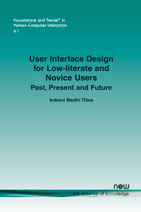User Interface Design for Low-literate and Novice Users: Past, Present and Future
By Indrani Medhi Thies, Microsoft Research India, Bangalore, India, indranim@microsoft.com
Abstract
One of the greatest challenges in providing information and communication technology access is that about 775 million people in the world are completely non-literate and many are able to read only with great difficulty and effort. Even though mobile phone penetration is growing very fast, people with low levels of literacy have been found to avoid complex functions, and primarily use mobile phones for voice communication only. This monograph looks at how we can design ICT user interfaces (UIs) such that novice and low-literate users can access a broad range of services and utilities, increasingly available to them, with minimal training and external assistance. It begins by observing the challenges in designing for low-literate users, and in conducting user studies among low-income communities in the developing world. It discusses techniques used by researchers in overcoming some of these challenges. It presents a review of existing examples of UIs for novice and low-literate users, which have used various combinations of input-output modalities other than text. It goes on to discuss strong trends that are starting to emerge in this design space and concludes with opportunities and future directions for research and design of UIs targeted at populations with low-literacy.
User Interface Design for Low-literate and Novice Users
One of the greatest challenges in providing information and communication technology access is that about 775 million people in the world are completely non-literate and many are able to read only with great difficulty and effort. Even though mobile phone penetration is growing very fast, people with low levels of literacy have been found to avoid complex functions, and primarily use mobile phones for voice communication only.
User Interface Design for Low-literate and Novice Users: Past, Present and Future looks at how we can design information and communications technology (ICT) user interfaces (UIs) in a way that novice and low-literate users can access a broad range of services and utilities, increasingly available to them, with minimal training and external assistance. It begins by observing the challenges in designing for low-literate users, and in conducting user studies among low-income communities in the developing world. It discusses techniques used by researchers in overcoming some of these challenges. It presents a review of existing examples of UIs for novice and low-literate users, which have used various combinations of input-output modalities other than text. It goes on to discuss strong trends that are starting to emerge in this design space and concludes with opportunities and future directions for research and design of UIs targeted at populations with low-literacy.
User Interface Design for Low-literate and Novice Users: Past, Present and Future is relevant for anyone with an interest in user experience design and technology for global development.
